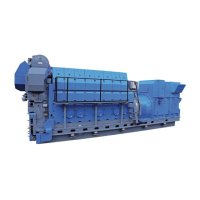Application: To control the power flow, between to
two more power producing plants. The plants are
not allowed to fed or heat each other.
Function 1: adjust the power flow or decoupling the
plants. If it is over the limit.
Function 2: Protecting generator, by tripping the
alternator circuit breaker.
Negative sequence
ANSI-code: 46
Application: to protect the alternator against imbal-
ance loading of the phases or loss of phase. If there
is a difference between the phases, this will create a
negative rotating vector system in the alternator,
which will produce harmonics and course heating of
the rotor.
Function: Protecting generator, by tripping the gen-
erator circuit breaker.
Field failure protection
ANSI-code: 40
Application: To protect the synchronous generator
against operation outside the stable operation area
due to loss of excitation. When partial or complete
loss of excitation occurs on a synchronous machine
it obtaining reactive power, it flows from the system
into the machine and the apparent impedance as
viewed from the machine terminals, goes into the
negative X region in the R-X diagram.
The Field failure system detects the low or under
impedance condition. Max. 15% 2sec
Function: Protecting generator, by tripping the alter-
nator circuit breaker.
Alternator differential protection
ANSI-code: 87G
Differential protection of alternator compares cur-
rent in two measuring points, the star point with the
current at the bus bar; it is a fast and selective form
of protection. Faults lying within the protected zone
are clearly and rapidly detected and reacted by
switching the alternator of to limit the fault damage.
The type of faults which occurring is insulation fail-
ure.
Faults between stator and windings
Stator earth faults.
Ground faults and faults between phases outside
the alternator but within the protected zone, at the
terminal or on external connections.
Function: Protecting alternator, by tripping the alter-
nator circuit breaker.
Temperature monitoring
IEC/EN 60751
Protection that detects abnormal temperature build
up inside the alternator windings. The measurement
is done by sensors placed inside the stator winding
in the slots. There at two types
PT 100 Ohm normal 2 x 3 pcs with three Leeds pr.
Sensor. (Base Module)
PT1000 Ohm normal 2 x 3 pcs with three Leeds pr.
Sensor (SaCos One)
Thermistors or thermocouples 2 x 3 pcs. whit two
leads for each sensor.
Alternator bearing protection can also be done by a
PT100 / PT1000 Sensor
Synchronising protection
ANSI-code: 79
The synchronising protection is to protect the gen-
erator set when synchronising with the grid or other
rotating GenSets. To do this it is necessary to
detect the Phase angel position and acceleration,
the phase angel must not be more than 2 deg.
Voltage difference, max 2%
Frequency difference, max 100mHz, min 98%, max
102%
To determine the max. acceptable tolerance, where
the switching can be done safely.
Function: Protecting alternator, by blocking the
switching on of the alternator circuit breaker.
Surge arrestors
IEC 60871-1, IEEE18, NEMA CP-1, VDE 0560 part
410, CIGRE 13.02
Is installed to protect the alternator insulation and
electronics against lightning and bad synchronisa-
tion, and in rush peaks from transformers and large
consumers. To do this, it is necessary to mount the
arrestors direct at or near to the alternator (within a
few meters from the terminals), the earth connec-
MAN Diesel & Turbo
B 17 00 0
Power Management - Alternator protection
3700383-8.2
Page 2 (6)
L23/30DF, L28/32DF, V28/32S, L28/32S, L28/32H, L27/38S, L27/38, L23/30S,
L23/30H, L21/31S, L21/31, L16/24S, L16/24
2015.11.17

